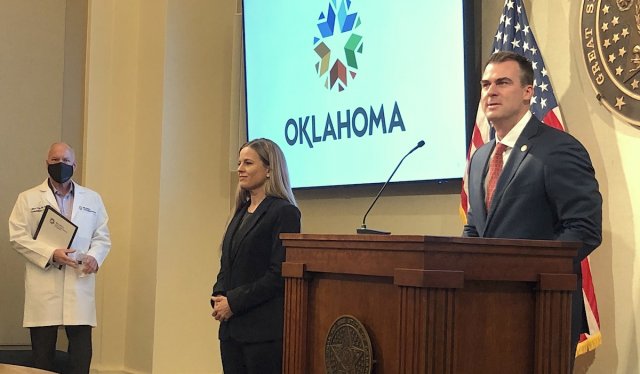Gov. Kevin Stitt signed a new executive order Friday morning that removes most of his public restrictions aimed at controlling the novel coronavirus’ spread in Oklahoma’s 77 counties while also leaving in place some elements of the state of emergency declaration he signed last year.
Among the most notable changes:
- There are no longer restrictions on the size of indoor public gatherings.
- The mandate that state employees wear masks inside state buildings has been removed.
- There are no limits on the size of public gatherings.
“More Oklahomans are getting vaccines each day, and I said from the very beginning the standard for normal can’t be zero cases,” Stitt said at a press conference Thursday. “In Oklahoma, the standard for normal is freedom.”
Some elements remain
Several elements of previous orders by Stitt remain in place under the updated executive order. All 77 counties remain in a state of emergency, which continues the order signed by Stitt last year at this time.
State agencies may still make emergency acquisitions necessary to fulfill the purpose of the emergency declaration.
State agencies can still employ additional staff in their responses to the novel coronavirus. Agencies can also continue to conduct virtual meetings when appropriate.
Any medical professional that holds a medical license can continue to practice in Oklahoma until that license expires pursuant to the Emergency Management Compact.
Finally, Stitt is still directing hospitals to report new cases, deaths and hospitalizations to the State Department of Health.
Municipal mask ordinances still in place
Despite the rollback of many safeguard measures, cities are still free to institute their own mask mandates.
Recently, Norman extended its mask mandate through June 1 with a declaration from Mayor Breea Clark.
Earlier this year, the Tulsa City Council voted to extend its mask ordinance through April 30.
On March 2, the OKC City Council also voted to extend the city’s mask ordinance through the end of April. It had been set to expire this month.
The Edmond City Council voted in February to extend that city’s mask ordinance, which requires face coverings to be worn in public spaces, through March 23.
In Lawton, the municipal mask ordinance will remain in place until the end of the governor’s state of emergency declaration.
Oklahoma cases in decline
Currently, there are 28 counties in the Oklahoma State Department of Health’s “orange” risk category and another 48 in the “yellow” risk category.
Since the pandemic began, 431,366 Oklahomans have tested positive for the novel coronavirus, with 7,486 deaths reported by OSDH and the CDC. The state’s seven-day rolling average of new cases has been in decline recently, with an average of 544 per day over the last week roughly matching the average daily new cases from July 2020.
So far, about 1.3 million Oklahomans have begun or completed the vaccination process for the novel coronavirus, making the state one of the best in the country in terms of getting its population inoculated. About 12 percent of the state’s population has received two doses of either the Moderna or Pfizer vaccine. The state also began distributing the new Johnson and Johnson vaccine which only requires one dose.
But despite the declining numbers, public health experts continue to warn people to be vigilant. The presence of new variants of the disease, including those from the United Kingdom, Brazil and South Africa, could cause case numbers to increase even as the nation’s population is vaccinated.
Oklahoma State Medical Association President George Monks said in a statement this week that it is the wrong time to ease restrictions.
“Letting up on our efforts to battle COVID now is like a football player spiking the ball at the five-yard line. We are nearing the goal, but we are not there yet,” he said.






















